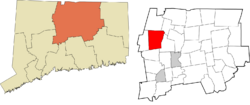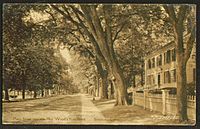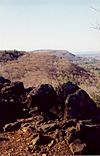Simsbury, Connecticut facts for kids
Quick facts for kids
Simsbury
|
|||
|---|---|---|---|
| Town of Simsbury | |||
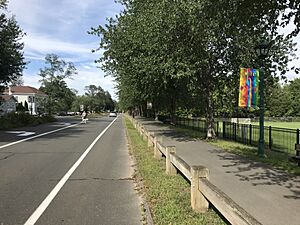
The Farmington Canal Heritage Trail in Simsbury
|
|||
|
|||
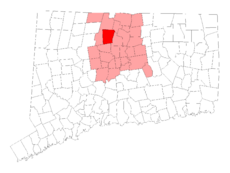 Hartford County and Connecticut Hartford County and Connecticut |
|||
| Country | |||
| U.S. state | Connecticut | ||
| County | Hartford | ||
| Region | Capitol Region | ||
| Settled | 1642 | ||
| Named | 1670 | ||
| Government | |||
| • Type | Town Manager/Board of Selectmen | ||
| Area | |||
| • Total | 34.3 sq mi (88.8 km2) | ||
| • Land | 33.9 sq mi (87.9 km2) | ||
| • Water | 0.4 sq mi (1.0 km2) | ||
| Elevation | 233 ft (71 m) | ||
| Population
(2020)
|
|||
| • Total | 24,517 | ||
| • Density | 715.1/sq mi (276.09/km2) | ||
| Time zone | UTC−5 (Eastern) | ||
| • Summer (DST) | UTC−4 (Eastern) | ||
| ZIP Codes |
06070, 06081, 06089, 06092
|
||
| Area code(s) | 860/959 | ||
| FIPS code | 09-68940 | ||
| GNIS feature ID | 0213506 | ||
Simsbury is a town in Hartford County, Connecticut, United States. It became Connecticut's 21st town in May 1670. The town is part of the Capitol Planning Region. In 2020, about 24,517 people lived here.
Contents
History of Simsbury
Who Lived in Simsbury First?
At the start of the 1600s, the area now known as Simsbury was home to Native American groups. One of these groups was the Wappinger. They were made up of eighteen smaller bands. These bands lived between the Hudson and Connecticut rivers.
The Wappingers were part of the Algonquian peoples. This is a large group of tribes who spoke similar languages. One Wappinger band, the Massaco, lived near the Farmington River. This area later became Simsbury and Canton.
How Simsbury Was Settled
In 1633, Windsor became the second town in Connecticut settled by Europeans. It was the first English settlement. For a while, the Massaco area was seen as an "appendix to the towne of Windsor." Settlers from Windsor used the land for farming and forestry. However, they did not live there permanently for many years.
In 1642, the colony of Connecticut's General Court allowed land to be given to Windsor residents. Five years later, the Court wanted the Massaco land to be bought by the colony. They wanted a group to decide who could use the land. But no land grants happened right away.
In 1643, John Griffin and Michael Humphrey started a business in Windsor. They made tar and turpentine. A Massaco Indian named Manahanoose accidentally started a fire. It destroyed Griffin's tar. The Court ordered Manahanoose to pay a large amount of wampum. Since he could not pay, he gave a deed to the Massaco land instead. Other Massaco leaders also agreed to this deed.
In 1653, the General Court gave land in Massacoe to three settlers. Lieutenant Aaron Cook received 50 acres. John Bissell got 60 acres, and Thomas Ford received 50 acres.
First Permanent Homes
Settlers did not build permanent homes until the 1660s. Aaron Cook built one of the first homes around 1660. This area became known as Terry's Plain. John Griffin also built a home, possibly in 1664.
By 1669, a survey showed thirteen people living permanently in Massacoe. John Case was appointed as the constable. This was the first official job held by a resident there.
Becoming a Town: Simsbury's Incorporation
In 1670, John Case, Joshua Holcomb, and Thomas Barber asked the General Court to make Massacoe a town. On May 12, 1670, their request was approved. The new town was named "Simmsbury."
At that time, Simsbury's borders were Farmington to the south and Windsor to the east. Simsbury stretched 10 miles north of Farmington and 10 miles west of Windsor. This large area included what are now Granby and Canton. These towns later separated from Simsbury in 1786 and 1806.
The exact reason for the name "Simsbury" is not fully known. Town records from the first ten years were lost in fires in 1680 and 1681. One idea is that it came from Symondsbury, an English town. Joshua Holcomb was from Symondsbury. Another idea is that it came from Simon Wolcott's nickname, "Sim." He was an important man in the town.
King Philip's War and Simsbury's Destruction
In 1675, there were rumors of trouble with Native American groups. These rumors were true, and King Philip's War began that summer. This war was between several tribes and the New England settlers. Simsbury was on the western edge of this conflict. It was considered a frontier settlement.
The war mostly ended by August 1676. The colony of Connecticut formed a Council of War. They told settlers to keep night watches and work in armed groups. By October 1675, the situation was so serious that Simsbury residents were ordered to move to safety in Windsor.
In March 1676, Simsbury was first robbed, then completely burned down. This was one of the worst destructions in any Indian War in New England. The settlers stayed in Windsor until the spring of 1677. Most of them then returned to Simsbury.
The Story of Daniel Hayes
In 1707, Daniel Hayes, who was 22 years old, was captured by Native Americans. He was taken to Canada. A rescue party tried to follow, but they could not catch up. Hayes was tied up every night. It took 30 days to reach Canada.
There, Hayes was forced to run the gauntlet. This was a form of punishment. He hid in a wigwam to avoid a blow. The woman in the wigwam had lost her husband and son in a war. She adopted Hayes as her son. He stayed with her for several years.
Later, he was sold to a Frenchman. The Frenchman learned Hayes was a skilled weaver. Hayes worked and earned enough money to buy his freedom after two years. He then returned to Simsbury, started a farm, and got married. He became an important person in the town and the church.
The Patent Safety Fuse Factory Explosion
On December 20, 1859, a factory in Simsbury exploded. This was the two-story Patent Safety Fuse factory. Seven women and one man were killed. Several others, including the factory owner, were hurt. The factory made fuses used for blasting. This led to the explosion. The New York Times reported on the event two days later.
Simsbury's Geography and Nature
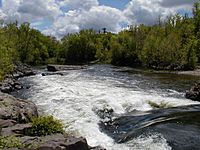
Simsbury covers about 88.8 square kilometers (34.3 square miles). Most of this is land, with about 1.0 square kilometer (0.4 square miles) of water.
Simsbury is located at the northern end of the Farmington Valley. On its east side is Talcott Mountain. This mountain is part of the Metacomet Ridge. This ridgeline is made of trap rock and stretches across Connecticut.
Important places on the Metacomet Ridge in Simsbury include Heublein Tower, Talcott Mountain State Park, and Penwood State Park. The Farmington River also flows through the Tariffville Gorge here. The 51-mile-long Metacomet Trail runs along this ridge.
At the base of the mountain, near the Farmington River, grows the Pinchot Sycamore. This is the largest tree in Connecticut. In 1998, it was 26 feet around and 95 feet tall. Its branches spread out 140 feet wide.
Simsbury also has areas of old-growth forest. Belden Forest is a 40-acre site with public hiking trails. It became part of the Old-Growth Forest Network in 2019.
Many people who live in Simsbury work in nearby Hartford, Connecticut. Hartford is about a 20 to 25-minute drive from Simsbury Center. However, many residents also travel to other towns and cities for work.
Main Communities in Simsbury
After the town was destroyed in 1676, three main communities were rebuilt. These were East Weatogue (also called East Simsbury), Simsbury Center, and Terry's Plain.
Today, Simsbury has four main areas that are recognized as census-designated places. These are Simsbury Center, Tariffville, Weatogue, and West Simsbury.
Simsbury's Climate
| Climate data for Simsbury, Connecticut | |||||||||||||
|---|---|---|---|---|---|---|---|---|---|---|---|---|---|
| Month | Jan | Feb | Mar | Apr | May | Jun | Jul | Aug | Sep | Oct | Nov | Dec | Year |
| Record high °F (°C) | 72 (22) |
73 (23) |
89 (32) |
96 (36) |
99 (37) |
101 (38) |
102 (39) |
102 (39) |
101 (38) |
91 (33) |
83 (28) |
76 (24) |
102 (39) |
| Mean daily maximum °F (°C) | 34 (1) |
39 (4) |
48 (9) |
61 (16) |
71 (22) |
80 (27) |
85 (29) |
83 (28) |
75 (24) |
63 (17) |
52 (11) |
40 (4) |
61 (16) |
| Mean daily minimum °F (°C) | 18 (−8) |
21 (−6) |
28 (−2) |
38 (3) |
48 (9) |
57 (14) |
63 (17) |
61 (16) |
53 (12) |
41 (5) |
33 (1) |
23 (−5) |
40 (5) |
| Record low °F (°C) | −26 (−32) |
−24 (−31) |
−8 (−22) |
9 (−13) |
28 (−2) |
37 (3) |
44 (7) |
36 (2) |
27 (−3) |
17 (−8) |
1 (−17) |
−18 (−28) |
−26 (−32) |
| Average precipitation inches (mm) | 3.23 (82) |
3.00 (76) |
3.62 (92) |
3.72 (94) |
4.35 (110) |
4.35 (110) |
4.18 (106) |
3.93 (100) |
3.88 (99) |
4.37 (111) |
3.89 (99) |
3.44 (87) |
45.96 (1,166) |
People of Simsbury
| Historical population | |||
|---|---|---|---|
| Census | Pop. | %± | |
| 1820 | 1,875 | — | |
| 1850 | 2,737 | — | |
| 1860 | 2,410 | −11.9% | |
| 1870 | 2,051 | −14.9% | |
| 1880 | 1,830 | −10.8% | |
| 1890 | 1,874 | 2.4% | |
| 1900 | 2,094 | 11.7% | |
| 1910 | 2,537 | 21.2% | |
| 1920 | 2,958 | 16.6% | |
| 1930 | 3,625 | 22.5% | |
| 1940 | 3,941 | 8.7% | |
| 1950 | 4,822 | 22.4% | |
| 1960 | 10,138 | 110.2% | |
| 1970 | 17,475 | 72.4% | |
| 1980 | 21,161 | 21.1% | |
| 1990 | 22,023 | 4.1% | |
| 2000 | 23,234 | 5.5% | |
| 2010 | 23,511 | 1.2% | |
| 2020 | 24,517 | 4.3% | |
| U.S. Decennial Census | |||
In 2000, there were 23,234 people living in Simsbury. There were 8,527 households and 6,591 families. The population density was about 685.7 people per square mile.
About 95.3% of the people were White. About 1.17% were African American, and 2.12% were Asian. About 1.54% of the population were Hispanic or Latino. The largest ethnic groups were Irish (23.0%), English (17.4%), German (15.6%), Italian (13.7%), and Polish (7.6%).
About 41.1% of households had children under 18. Most households (69.1%) were married couples. The average household had 2.70 people. The average family had 3.12 people.
About 29.5% of the population was under 18. About 12.5% were 65 or older. The average age was 40 years old.
In 2018, the average household income was $119,588. The income per person was $60,453. About 2.2% of the population lived below the poverty line. This included 1.6% of those under 18.
What Are Simsbury's Top Employers?
Simsbury has several important employers. These companies provide many jobs for the town's residents. Here are the top employers in Simsbury as of 2023:
| # | Employer | # of employees |
|---|---|---|
| 1 | Simsbury Board of Education | 651 |
| 2 | Wings Media Group | 500-999 |
| 3 | Everest Global Svc | 500-999 |
| 4 | Chubb | 250-499 |
| 5 | Keller Williams Realty | 250-499 |
| 6 | Hoffman Auto Group | 250-499 |
| 7 | McLean Home Care | 250-499 |
| 8 | The Hartford | |
| 9 | Ensign-Bickford Company | |
| 10 | Stop & Shop |
Important Places and Landmarks in Simsbury
Simsbury is home to many interesting places. These include schools, parks, and historic sites.
- The Ethel Walker School, The Master's School, St. Mary's School, and Westminster School are private schools.
- The International Skating Center of Connecticut is located here.
- Three state parks in Hartford County are in Simsbury: Penwood State Park, Stratton Brook State Park, and Talcott Mountain State Park.
- Simsbury Airport is a public airport. It is located in Simsbury and East Granby.
- Ensign-Bickford Industries was founded in Simsbury in 1836. Its main office is still in town.
- The Pinchot Sycamore is the largest tree in Connecticut.
Historic Places on the National Register
Several places in Simsbury are listed on the National Register of Historic Places. This means they are important for their history or architecture.
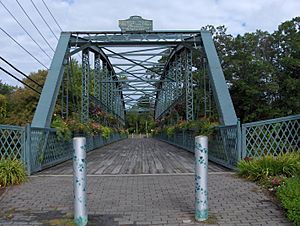
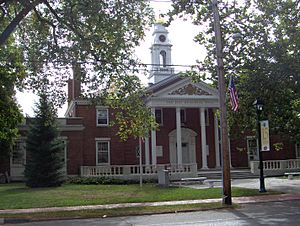
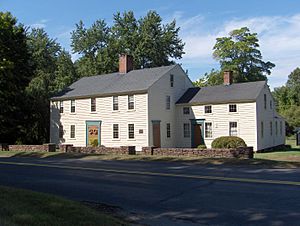
- Drake Hill Road Bridge: This bridge was built in 1892 over the Farmington River. It is a special type of bridge called a Parker truss. It used to carry cars but now is for walking and biking.
- East Weatogue Historic District: This area includes properties on East Weatogue Street.
- Heublein Tower: This tower is in Talcott Mountain State Park.
- John Humphrey House: This two-story house was built around 1760.
- Massaco Forest Pavilion: This is located in Stratton Brook State Park.
- Simsbury Center Historic District: This area covers Hopmeadow Street. It includes several important buildings:
- Amos Eno House: Also known as the Simsbury House, built by Elisha Phelps.
- Eno Memorial Hall: A significant building in the town center.
- Horace Belden School: Now the Town Hall and Police Station.
- Robert and Julia Darling House: A historic home.
- Capt. Elisha Phelps House: Built in 1771, it was a tavern for many years.
- Simsbury Bank and Trust Company Building: A historic bank building.
- Simsbury Railroad Depot: The old train station.
- Simsbury Townhouse: This was Simsbury's first town hall, built in 1839. It is a wooden building in the Greek Revival style.
- Tariffville Historic District: This area includes streets like Winthrop Street and Main Street.
- Terry's Plain Historic District: This area is bounded by Pharos, Quarry, and Terry's Plain Roads, and the Farmington River.
Schools in Simsbury
Simsbury has a variety of schools, both public and private, for students of all ages.
Public High Schools
- Simsbury High School: This school has about 1,457 students and serves grades 9–12.
Private High Schools
- Ethel Walker School: This is a girls-only school for grades 6–12, with about 252 students.
- The Master's School: This school has about 400 students and serves grades Pre-K through 12.
- Westminster School: This school has about 353 students and serves grades 9–12.
Public Primary and Middle Schools
- Central School: About 479 students, grades Pre-K–6.
- Henry James Memorial School: About 840 students, grades 7–8.
- Latimer Lane School: About 623 students, grades K–6.
- Squadron Line School: About 849 students, grades Pre-K–6.
- Tariffville School: About 280 students, grades K–6.
- Tootin' Hills School: About 537 students, grades K–6.
Private Primary and Middle Schools
- The Cobb School Montessori: About 145 students, grades Pre-K–5.
- St. Mary's School: About 264 students, grades K–8.
Famous People from Simsbury
Many interesting people have lived in or have connections to Simsbury.
Athletes
- Shizuka Arakawa (born 1981): Japanese figure skater who won a gold medal at the 2006 Winter Olympics. She trained in Simsbury.
- Oksana Baiul (born 1977): 1994 Olympic champion. She lived and trained in Simsbury.
- Sasha Cohen (born 1984): 2006 U.S. National Champion figure skater and Olympic silver medalist. She trained in Simsbury.
- Tommy Cross (born 1989): Professional ice hockey player.
- Ekaterina Gordeeva (born 1971): Winner of two Olympic gold medals in figure skating. She moved to Simsbury in the 1990s.
- Sara Hendershot (born 1988): Member of the 2012 United States Olympic Rowing Team.
- Paul Holmgren (born 1955): Former hockey coach and current president of the Philadelphia Flyers.
- Michelle Kwan (born 1980): Olympic figure skater. She has trained in Simsbury.
- Mike Liut (born 1956): Former NHL hockey goalie.
- Viktor Petrenko (born 1969): 1992 Olympic champion. He trained in Simsbury.
- Ulf Samuelsson (born 1964): Former NHL hockey player. He lived in Simsbury.
- Alexei Yagudin (born 1980): 2002 Olympic champion and four-time world champion in figure skating. He lived and trained in Simsbury.
People in Media
- Lake Bell (born 1979): Actor, attended Westminster School in Simsbury.
- Rachel Sennott (born 1995): Actor, graduated from Simsbury High School.
- Sigourney Weaver (born 1949): Actor, attended Ethel Walker School in Simsbury.
Politicians
- George McLean (1857–1932): U.S. senator and Simsbury resident. He founded the 4,200-acre McLean Game Refuge in town.
- Alice Merritt (1876–1950): The first woman to serve in the Connecticut State Senate. She was born in Simsbury.
- Gifford Pinchot (1865–1946): The first Chief of the United States Forest Service. He was also Governor of Pennsylvania and was born in Simsbury.
Other Notable People
- Sherri Browning Erwin (born 1968): Author and current resident.
- Justin Foley (born 1976): Musician, drummer for the band Killswitch Engage. He was born in Simsbury.
- Samuel Higley (1687–1737): Thought to have made the first copper coins in the colonial United States.
- Martin Luther King Jr. (1929–1968): Worked on a tobacco farm in Simsbury during the summers of 1944 and 1947 to earn money for college.
- Franz Von Holzhausen: Car designer at Tesla, grew up in Simsbury.
- Jennifer Weiner (born 1970): Author.
- Carl Nichols (born 1970): A United States district judge. He grew up in Simsbury.
Simsbury's Sister City
Simsbury has a sister city relationship with:
- Wittmund, Lower Saxony, Germany
See also
 In Spanish: Simsbury para niños
In Spanish: Simsbury para niños




